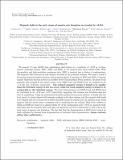Por favor, use este identificador para citar o enlazar a este item:
http://hdl.handle.net/10261/235378COMPARTIR / EXPORTAR:
 SHARE SHARE
 CORE
BASE CORE
BASE
|
|
| Visualizar otros formatos: MARC | Dublin Core | RDF | ORE | MODS | METS | DIDL | DATACITE | |

| Título: | Magnetic Fields in the Early Stages of Massive Star Formation as Revealed by ALMA |
Autor: | Liu, Junhao; Zhang, Qizhou; Qiu, Keping; Liu, Hauyu Baobab; Pillai, Thushara G. S.; Girart, Josep Miquel CSIC ORCID ; Li, Zhi-Yun; Wang, Ke | Palabras clave: | Polarization Magnetic fields ISM: individual objects (IRDC G28.34+0.06) Stars: formation |
Fecha de publicación: | 1-jun-2020 | Editor: | IOP Publishing | Citación: | Astrophysical Journal 895(2): 142 (2020) | Resumen: | We present 1.3 mm ALMA dust polarization observations at a resolution of ∼0.02 pc for three massive molecular clumps, MM1, MM4, and MM9, in the infrared dark cloud G28.34+0.06. With these sensitive and high-resolution continuum data, MM1 is resolved into a cluster of condensations. The magnetic field structure in each clump is revealed by the polarized emission. We found a trend of decreasing polarized emission fraction with increasing Stokes I intensities in MM1 and MM4. Using the angular dispersion function method (a modified Davis-Chandrasekhar-Fermi method), the plane-of-sky magnetic field strengths in two massive dense cores, MM1-Core1 and MM4-Core4, are estimated to be ∼1.6 mG and ∼0.32 mG, respectively. The virial parameters in MM1-Core1 and MM4-Core4 are calculated to be ∼0.76 and ∼0.37, respectively, suggesting that massive star formation does not start in equilibrium. Using the polarization-intensity gradient-local gravity method, we found that the local gravity is closely aligned with intensity gradient in the three clumps, and the magnetic field tends to be aligned with the local gravity in MM1 and MM4 except for regions near the emission peak, which suggests that the gravity plays a dominant role in regulating the gas collapse. Half of the outflows in MM4 and MM9 are found to be aligned within 10 of the condensation-scale (<0.05 pc) magnetic field, indicating that the magnetic field could play an important role from condensation to disk scale in the early stage of massive star formation. | Versión del editor: | http://doi.org/10.3847/1538-4357/ab9087 | URI: | http://hdl.handle.net/10261/235378 | DOI: | 10.3847/1538-4357/ab9087 | Identificadores: | doi: 10.3847/1538-4357/ab9087 issn: 1538-4357 |
| Aparece en las colecciones: | (ICE) Artículos |
Ficheros en este ítem:
| Fichero | Descripción | Tamaño | Formato | |
|---|---|---|---|---|
| Magnetic_fields_in_the_early_stages_of_massive_star_formation.pdf | 2,28 MB | Adobe PDF |  Visualizar/Abrir |
CORE Recommender
SCOPUSTM
Citations
20
checked on 25-abr-2024
WEB OF SCIENCETM
Citations
17
checked on 22-feb-2024
Page view(s)
80
checked on 30-abr-2024
Download(s)
99
checked on 30-abr-2024
Google ScholarTM
Check
Altmetric
Altmetric
NOTA: Los ítems de Digital.CSIC están protegidos por copyright, con todos los derechos reservados, a menos que se indique lo contrario.
